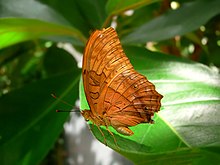Vindula arsinoe
| Vindula arsinoe | ||||||||||||
|---|---|---|---|---|---|---|---|---|---|---|---|---|

Vindula arsinoe , female |
||||||||||||
| Systematics | ||||||||||||
|
||||||||||||
| Scientific name | ||||||||||||
| Vindula arsinoe | ||||||||||||
| ( Cramer , 1777) |
Vindula arsinoe is a butterfly ( butterflies )found in Australia and Southeast Asiafromthe noble butterfly family (Nymphalidae).
features
butterfly
The wingspan of the moth is 75 to 82 millimeters. The species is characterized by a clear sexual dimorphism .
female
The wings of the females have an olive-brown to dark brown basic color. A whitish band runs through the disk region of the fore wings. Two eye spots on the upper side of the hind wings are larger than those of the males. The yellow-brown colored post-disk and submarginal regions are typical of the species . On the red-brown to olive-brown undersides of the wing, the pattern on the upper side shines through in a greatly weakened form. A sharply drawn dark brown cross line stands out clearly in the middle. The hind wings show very short, pointed tails.
male
The wings of the males have a strong orange base color. On the upper sides of the wing, a dark brown line runs along the hem from the apex of the forewings to the anal angle of the hind wings. In the post-disk region of the hind wings there are two small black eye spots with a thin orange-yellow border. On the yellow-brown undersides of the wings, the pattern on the upper side shines through in a greatly weakened form. What is striking, however, is a central, sharply drawn dark brown transverse line. The hind wings show very short, pointed tails.
Pre-imaginal stages
The egg has a creamy white to light brown color, a barrel-like shape and has many serrated longitudinal ribs on the surface.
The caterpillars are colored black. The entire surface of the body is covered with black and white, weakly branched thorns and whitish dots. The back line is creamy white.
The doll is designed as a falling doll and has a whitish green to brownish color. The wavy wing sheaths and three humps protrude conspicuously. There are two short tips on the head.
Similar species
- The males of Vindula dejone are darker at the apex, the females are generally lighter olive-brown and they lack the yellow-brown areas on the upper side of the hind wing.
- In Vindula erota , the males are generally less orange in color. In the females, the postdiskal and submarginal regions on the upper side of the hind wing have no yellow-brown color. The species does not occur in Australia. However, there is an overlap with Vindula arsinoe in Malaysia .
Distribution, subspecies and habitat
Vindula arsinoe occurs in eastern Australia as well as on New Guinea with the neighboring islands and in Malaysia. The species primarily inhabits tropical rainforests. 16 subspecies are currently listed in the individual occurrence areas .
- Vindula arsinoe arsinoe ( Cramer , 1777)
- Vindula arsinoe ada ( Butler , 1874)
- Vindula arsinoe insularis ( Salvin & Godman , 1877)
- Vindula arsinoe catenes ( Godman & Salvin , 1888)
- Vindula arsinoe clodia ( Godman & Salvin , 1888)
- Vindula arsinoe lemina ( Ribbe , 1898)
- Vindula arsinoe melena ( Fruhstorfer , 1899)
- Vindula arsinoe pisidike ( Fruhstorfer , 1903)
- Vindula arsinoe polycaste ( Fruhstorfer , 1903)
- Vindula arsinoe figalea ( Fruhstorfer , 1904)
- Vindula arsinoe adina ( Fruhstorfer , 1906)
- Vindula arsinoe meforica ( Fruhstorfer , 1906)
- Vindula arsinoe rebeli ( Fruhstorfer , 1906)
- Vindula arsinoe bosnikensis ( Joicey & Noakes , 1915)
- Vindula arsinoe dampierensis ( Rothschild , 1915)
- Vindula arsinoe rookiana (Beach, 1916)
- Vindula arsinoe moluccana Nieuwenhuis , 1962
Way of life
The moths fly in several generations throughout the year. They appear most numerous at the end of the monsoon season. They like to suck on flowers, for example on lantana ( Lantana ) and occasionally moist Erdstellen or excrement to accommodate liquid and minerals. The caterpillars prefer to feed on the leaves of passion flowers ( Passiflora ), Adenia or Hollrungia species.
Individual evidence
- ↑ Information from James Cook University
- ↑ Markku Savela: Tanaecia Butler (1869) - distribution. In: Lepidoptera and some other life forms. Retrieved February 15, 2019 .
- ↑ a b Michael F. Braby: The Complete Field Guide to Butterflies of Australia , CSIRO Publishing, Melbourne, 2016, ISBN 9781486301003 , p 186
- ^ Cramer's Cruiser, Butterflies of New Guinea
Web links
- lepidoptera.butterflyhouse - stages of development

